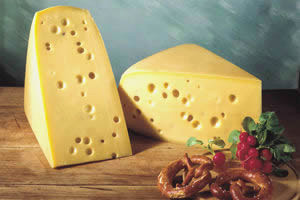Why Swiss Cheese Has Holes in It
 Today I found out why Swiss cheese has holes in it.
Today I found out why Swiss cheese has holes in it.
The holes come from a byproduct of some of the microbes added to milk to make Swiss cheese. Specifically, there are three primary types of bacteria that are typically used to make Swiss cheese (these can vary slightly depending on the manufacturer): Streptococcus thermophilus; Lactobacillus helveticus; and Propionibacterium shermanii.
The first two types of microbes produce significant amounts of lactic acid, which is, in turn, consumed by the latter type of microbes, Propionibacterium shermanii. It is this Propionibacterium shermanii that is responsible for the holes in Swiss cheese. Through the process of consuming the lactic acid, the shermanii produces acetate, propionic acid, and carbon dioxide as a byproduct.
The acetate and propionic acid give the Swiss cheese much of its distinct flavor, while the carbon dioxide forms bubbles within the cheese block or wheel. These carbon dioxide bubbles are left in as the cheese continues to ferment, rather than pressing them out, which gives Swiss cheese its distinctive holes. Historically, however, these holes were seen as an imperfection in the cheese and most manufacturers would try to avoid them by pressing this type of cheese during the aging process, to force the bubbles out and keep the cheese solid throughout the block or wheel.
Interestingly, the size of the holes in Swiss cheese sold in the United States is regulated by the U.S. Government. This is widely criticized by many Swiss cheese manufactures outside of the U.S., particularly in Switzerland, which tend to produce their cheese in a non-factory environment and thus, take more pride in the end product, rather then the bottom line. The reason for the protest is that the size of the holes is regulated by varying the curing time, acidity, and temperature, during the fermentation process, which typically lasts 60-100 days. These changes, however, also will significantly affect the texture and flavor of the cheese itself. Many foreign Swiss cheese manufactures claim that the regulations put forth by the American Government produce an inferior flavored Swiss cheese, hence the protest.
The U.S. Government created these regulations at the lobbying of commercial American Swiss cheese producers, who were having problems with their mechanical slicers cutting cheese when the Swiss cheese holes were too big, (typical sizes of the holes used to be around the size of a nickel). Rather than innovate or upgrade their equipment, they went with the age old practice of simply lobbying the government to make laws to fix their problem. Namely, to specify that, in order for Swiss cheese to be classified as “Grade A”, which is generally necessary for high volume sales in the United States, it must have holes no bigger than 3/8 of an inch, which is about half the typical size before these new regulations were put in place. This also significantly shortens the required aging time of North American style Swiss cheese, which also benefited the American mass-producers of the cheese.
Bonus Facts:
- True Swiss cheese is called Emmental. This is very similar to most types of North American Swiss cheese, except it’s typically aged much longer (over 100 days, instead of around 60 days) and tends to be made in non-factory settings, such as small village dairies. Emmental tends to have a softer texture and larger holes than North American Swiss cheese. The increased aging time also gives it a significantly richer flavor.
- Emmental gets its name from the location where it supposedly originated, Emme valley in the canton of Bern. Today it is popularly produced in France, Bavaria, Finland, and Switzerland.
- The two most popular varieties of Swiss cheese in the United States are Baby Swiss and Lacy Swiss. Both of these have a very mild flavor, due to the process required to make sure there are small holes to be able to qualify for the Grade A stamp. The primary difference between Baby Swiss and Lacy Swiss is simply that Baby Swiss is made from whole milk and Lacy Swiss is made from low fat milk.
- The state of Ohio produces over 64 million pounds of Swiss cheese every year, which is the highest amount produced by any state in the United States.
| Share the Knowledge! |
|





I was wondering why I couldn’t find the large hole swiss cheese that I remembered growing up with in the 80s-90s (but never wondered enough to spend any time looking into it). I think I just assumed it was another product lost for some reason when Winn-Dixie closed down in my state. Of course, this explanation makes a lot more sense now.
Oh for the love of Christ…they’re called EYES not HOLES, you hack. You think you could have at least ONCE mentioned this one simple detail.
Contrary to what cartoons have suggested over the years, the holes are not made by mice eating their way through the cheese.
And nor are they produced by carbon dioxide released by bacteria, as popular scientific belief held.
Instead, a Swiss laboratory says they are created by flecks of hay.
Agroscope, a Swiss government agricultural institute, said “microscopically small hay particles” would fall in to buckets collecting milk, and develop into bigger holes as the cheese matures.